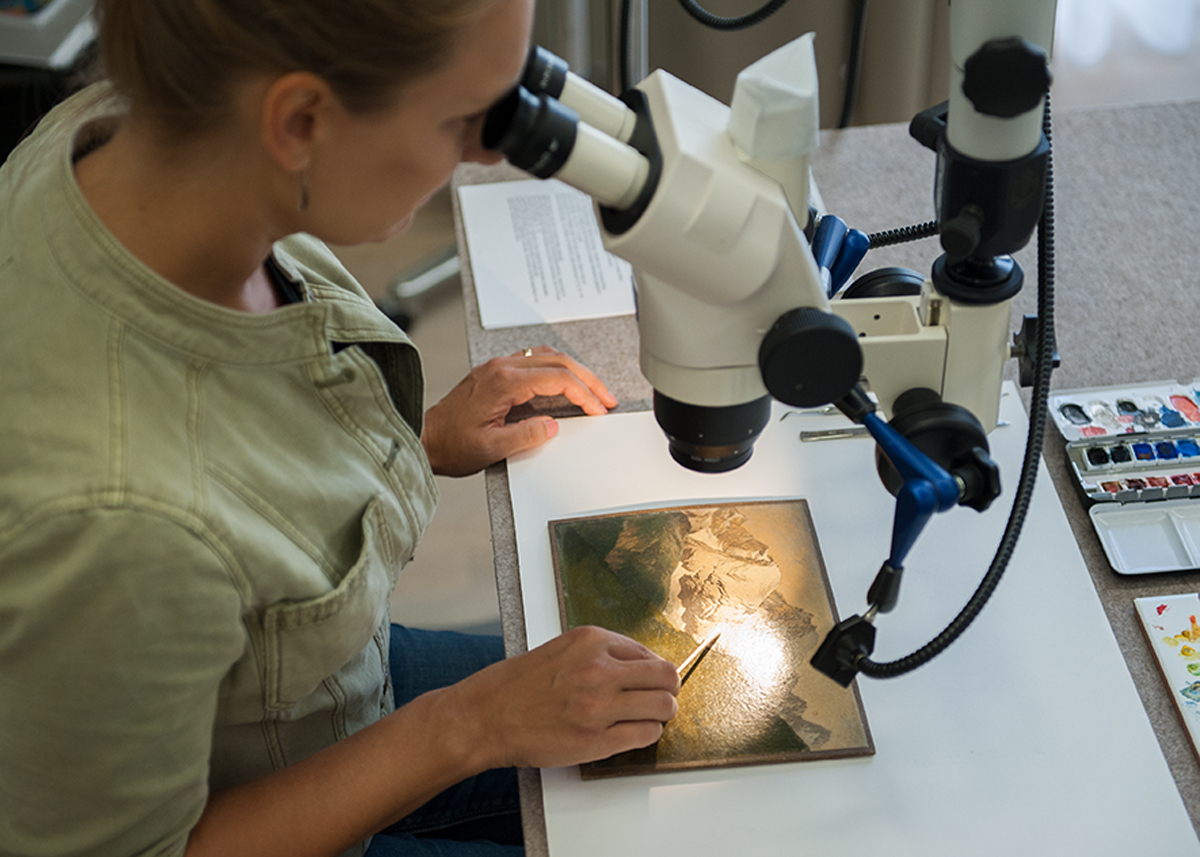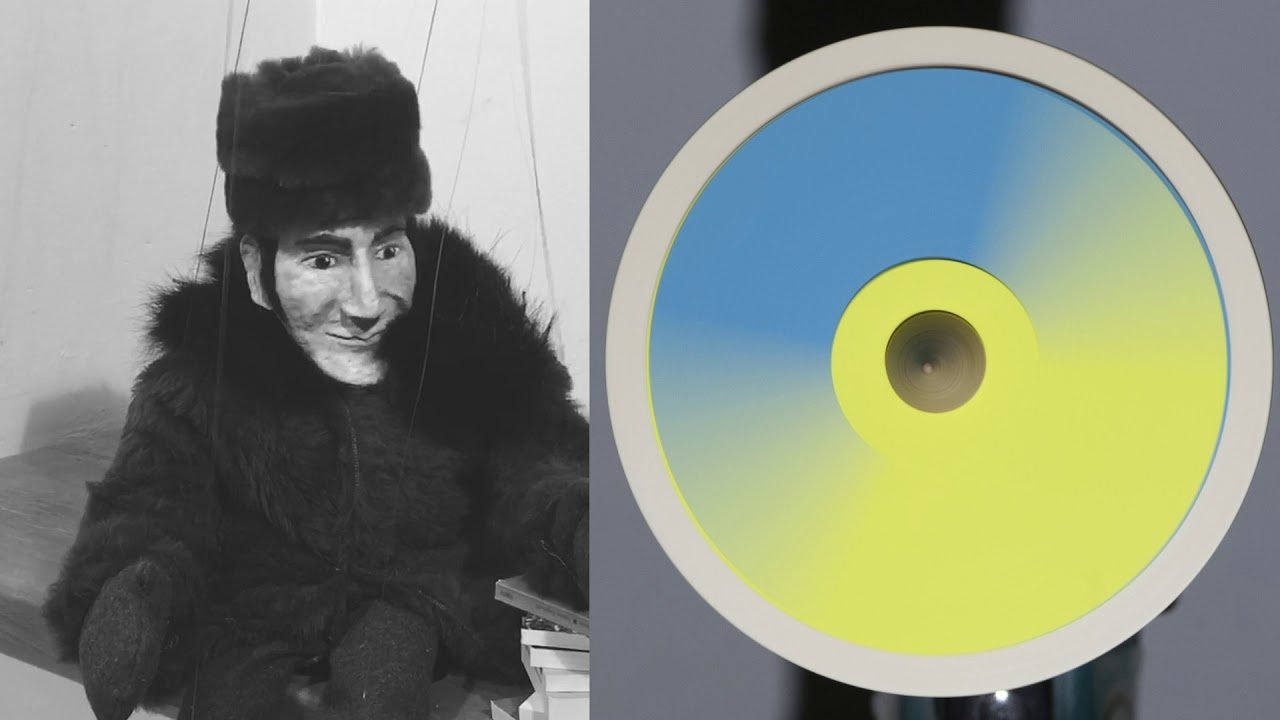Conservation
The conservation and restoration of our collections begins with preventive conservation. This includes all the various ways in which works of art and their environment need to be prepared to ensure the lasting preservation of the art and prevent damage. Paintings and graphic art require precise climate control, appropriate illumination, secure installation and mechanical protection, and, in some instances—consider Erwin Wurm's textile works or Joseph Beuys's objects—protection against insects. Especially delicate art is presented in individually manufactured microclimate frames.
Regular examination of the works in the collection helps us understand their particularities better. All paintings by the "Blue Rider" are framed with anti-glare museum glass and protective back covers. Special mounting systems secure the works in position. Graphic art is preserved using acid-free mattes and book boxes. The temporary picture frames designed especially for our collection allow for a presentation that is aesthetically appealing while meeting conservational requirements.
Conservation practice also includes certain interventions into the work itself, like the stabilization of paint layers or the consolidation of picture media such as the cardboards on which the artists of the "Blue Rider" painted, which have tended to become frayed. Such interventions are designed to maintain the original substance. Beyond such maintenance, restoration also involves techniques such as varnish removal, the use of adhesives to repair mechanical damage, retouching, and many other interventions. As the restoration of Franz von Stuck's "Salome" in time for the inauguration of the renovated Lenbachhaus illustrates, such restoration work may be quite extensive.
Newly purchased works of contemporary art frequently require no restoration at all. In these instances, we focus on conservation widely conceived, including the compilation of documentation. We record information, including information provided by the artist, about the substance of the work. New works often raise difficult and unusual questions: What is the right way to glue synthetic materials? How does one restore monochrome painted surfaces? How should video art be conserved? And how to restore contemporary photography? Attending conferences and exchanging ideas with other experts are important ways for us to stay involved in the discussion on these and other issues.
Preparing art for shipment to other institutions and loan supervision
When the Lenbachhaus receives a loan request, we first examine whether the object in question is suitable for transportation. It is then restored if necessary, framed with protective glass, and put in a special packing case. The condition of the work and any unusual features are recorded in inspection reports. Delicate and high-value works travel accompanied by a courier. In collaboration with the consignee, we work to ensure optimum climate control, safe shipment, and appropriate hanging of our art.
Work for exhibitions at the Lenbachhaus
In preparation for the museum's own exhibitions, we devote considerable resources to the careful restoration of works from our collections; for example, the Franz Marc retrospective in 2005–2006 occasioned the restoration of his "Blue Horse," and Kandinsky's "Colorful Life" was restored for "Kandinsky—Absolut. Abstrakt" in 2008–2009. The show "Kunst ist schön, macht aber viel Arbeit" in 2012–2013 presented an opportunity to prepare a large number of paintings, sculptures, and works on paper as well as photographs for the new presentation at the Lenbachhaus.
Before special exhibitions, we examine the condition of the art, the indoor climate, and the lighting. We determine the correct packaging and work closely with the Lenbachhaus’s exhibition installation team. We inspect loans and install them together with the couriers accompanying them. While the show is on view, we monitor the works at regular intervals and clean them when necessary. Once the exhibition closes, we supervise the process of packing the art up for shipping and examine its condition one last time before it leaves the Lenbachhaus.
The extensive and diverse holdings of the Lenbachhaus present opportunities for numerous research projects. We are especially interested in the painting techniques used by the creators of our most valuable collection, the art of the "Blue Rider." Even individual works, such as Franz von Stuck's "Salome," which underwent extensive restoration during the closure of the Lenbachhaus, may become subjects of studies and publications.
Also in 2018, we released a new volume in the "Edition Lenbachhaus" series. Titled "Franz Marcs Prisma" it explores Marc's use of prisms around 1911—a hitherto unexamined aspect of the artist's oeuvre. Collaborating with specialists from the Deutsches Museum, mineralogists, collectors of optical instruments, and experts in the theory of color, Iris Winkelmeyer, the Lenbachhaus’s head of conservation, has studied the role of prisms in the genesis of Marc's paintings and sheds light on their use as replication devices in the historic cultural context.
Further Reading
Daniel Oggenfuss: "Aus meiner Werkstatt". Zeichenutensilien und Technik in Kubins Frühwerk, in: Annegret Hoberg; Matthias Mühling (Hrsg.): Phantastisch! Alfred Kubin und Der Blaue Reiter, Köln 2018, S. 50–57.
Daniel Oggenfuss: Gabriel von Max. Russabdrücke im Nachlass Gabriel von Max, in: Karin Althaus; Helmut Friedel (Hrsg.): Gabriel von Max. Malerstar. Darwinist. Spiritist, München 2011, S. 50–54.
Daniel Oggenfuss: Kamera- und Verfahrenstechnik der Amerika-Photographien Gabriele Münters, in: Helmut Friedel (Hrsg.): Gabriele Münter. Die Reise nach Amerika. Photographien 1899-1900, München 2006, S. 189–201.
Theresa Bräunig, Iris Winkelmeyer: 3-D Rekonstruktion der Gestaltung eines spätgotischen Kruzifixes aus Franz von Lenbachs Sammlung, in: Zeitschrift für Kunsttechnologie und Konservierung (ZKK), Vol. 30, Heft 1, 2016, S. 183–196.
Helmut Friedel (Hrsg.) mit Beiträgen von Barbara Eschenburg und Iris Winkelmeyer: Paul Klee. Botanisches Theater, München 2005.
Ulrike Fischer; Heike Stege; Daniel Oggenfuss; Cornelia Tilenschi; Susanne Willisch; Iris Winkelmeyer: "...I came to understand how to translate nature into colour according to the fire in my soul": Alexej Jawlensky's painting technique in his munich oeuvre, in: The object in context: crossing conservation boundaries. Contributions to the Munich Congress 28 August – 1 September 2006, Editors David Saunders, Joyce H. Townsend and Sally Woodcock, London 2006, S. 49–55.
Simon Steger; Diana Oesterle; Simone Bretz; Lisa Frenzel; Heike Stege; Iris Winkelmeyer; Oliver Hahn; Gisela Geiger: "Kandinsky’s fragile art": A multidisciplinary investigation of four early reverse glass paintings (1911–1914) by Wassily Kandinsky, in: Heritage science, 7 (27), 2019.
Iris Winkelmeyer: "Contemporary Art made of Polyurethane soft foam": Production – Ageing – Conservation – Storage, in: Gerhard Banik (Hrsg.): Wege zur Konservierungswissenschaft. Projekte am Studiengang Restaurierung und Konservierung von Graphik, Archiv- und Bibliotheksgut. Staatliche Akademie der Bildenden Künste 2000–2008, Stuttgart 2010, S. 85–86.
Iris Winkelmeyer (Hrsg.) mit Beiträgen von Susanne Gaensheimer und Felicia Rappe: Danaé Xynias, Ausst. Kat., München 2013.
Iris Winkelmeyer: "Das Botanische Theater". Eine kunsttechnologische Untersuchung, in: Helmut Friedel (Hrsg.): Paul Klee. Botanisches Theater, München 2005, S. 37–45.
Iris Winkelmeyer: "El cosmos de color de Kandinsky": Tecnología artística de los años 1896 a 1914, (dt.: "Kandinskys farbiger Kosmos": Kunsttechnologie der Jahre Jahre 1896–1914), in: Institutio Nacional de Bellas Artes, Museo del Palacio Bellas Artes (Hrsg.): Kandinsky – pequeños mundos, Ausst. Kat., Mexico City 2018, S. 175–198.
Iris Winkelmeyer: Franz Marcs Prisma, Edition Lenbachhaus – 5, München 2018.
Iris Winkelmeyer: "Never use Water!" Stuck und die Temperarenaissance in München um 1900, in: Matthias Mühling (Hrsg.): Franz von Stuck. Salome, Edition Lenbachhaus – 1, München 2014, S. 45–77.
Iris Winkelmeyer: "Perfection for an Instant". Restaurierungsmodell einer Skulptur aus Polyurethanweichschaum, in: Zeitschrift für Kunsttechnologie und Konservierung (ZKK), Vol. 14, 2000, Heft 2, S. 378–383.
Iris Winkelmeyer: Perfection is good for an instant, in: Marianne Stockebrand, John Chamberlain. The Foam Sculptures, The Chinati Foundation, Marfa, 2007, S. 24–28.
Iris Winkelmeyer: Perfection vor an Instant, in: Thea v. Oosten (Hrsg.), Plastics in Art, München 2002, S. 153–164.
Iris Winkelmeyer: "Rot – Rouge – Red – Rosso". Ein maltechnisches Projekt, in: Michael Fehr (Hrsg.): Die Farbe hat mich, Hagen 2000, S. 282–290.
Iris Winkelmeyer: Zeitgenössische Kunst aus Polyurethanweichschaum. Entstehung - Zerfall – Erhalt – Lagerung, Diplomarbeit, Staatliche Akademie der Bildenden Künste Stuttgart, Stuttgart 2000.





